by Winding Pathways | Nov 21, 2019 | (Sub)Urban Homesteading, Birds, Foraging, Garden/Yard, Nature, Trees
A New World Thanksgiving
Almost every meal Americans enjoy comes from animals and plants that trace their origin to many continents.
Cattle, sheep, chickens, and pigs, for example, are all natives of the Old World brought to America soon after it was settled by Europeans. Wheat, rice, and many other plant foods are also newcomers that were unknown to Native Americans.
One annual feast mostly made from original American foods is Thanksgiving. This year why not create this traditional feast from entirely plants and animals that were found here before Columbus?
Turkeys
Turkey highlights the Thanksgiving dinner. See our previous blog on this amazing and tasty bird. Here are plants native to North and South America to complement roast turkey:
Fruits and Vegetables
Corn: Corn has been grown in Central America for thousands of years. It’s cultivation gradually spread north and east and became a staple food for Native Americans. When hungry Pilgrims landed in what became Massachusetts they found and stole caches of corn stored by local tribes, no doubt causing bad feelings.
Cranberries: Most commonly eaten fruits originated in Europe or Asia, but the cranberry is an American native.
Squash and Pumpkins: Dozens of varieties of winter squash come in many shapes, colors and sizes, and the pumpkin is actually a squash. Butternut, Hubbard, acorn, or any other squash is delicious on the Thanksgiving dinner table, and dessert of pumpkin pie rounds out a tasty meal.
Potatoes: Common potatoes also originated in South or Central America and have been an important food for thousands of years. Mashed or baked, they go well with turkey, squash, and cranberries.
Sweet Potatoes: Originally from South America, these are among the most nutritious of foods. Similar yams have an African origin, so for a local dinner stick with sweet potatoes.
The sweetness from the Maples
Maple Syrup: While honey is made by bees that came from the Old World, maple syrup is America’s sweetener. It’s delicious on squash or sweet potatoes.
Beans: Native American gardens usually featured three plants: beans, squash, and corn. Commonly called The Three Sisters combined they create a balanced diet.
A diet of many foods that originally came from the Americas makes a delicious an interesting Holiday meal. We tend to thank modern geneticists for creating abundant food, but beans, corn, squash, sweet potatoes, maple syrup, cranberries, and turkey were all domesticated and enjoyed by Native Americans long before Columbus set sail.
-

-
Cranberry Pie brightens any Thanksgiving table.
-
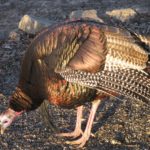
-
Cook Wild turkey differently than domesticated ones.
-
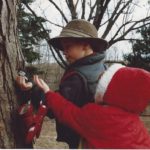
-
Maple syrup can sweeten many Thanksgiving meals.
by Winding Pathways | Nov 7, 2019 | Nature, Travel/Columns, Trees
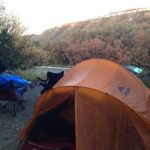
Enjoying Iowa’s forests.
Iowa is one of the states with the fewest trees, yet in the late 1800s we were the Lumber Kings of the World! And,

Notice the tree rings on this wide board from New Hampshire
Clinton, Iowa’s minor league baseball team proudly retains that name – Lumber Kings! Why? Read The Green Gazette (9-29-2019, Living L-09 and 10) to learn about Iowa’s forest industry, where you can camp today in quiet forests and how lumbering put Clinton, Iowa, on the map.
by Winding Pathways | Sep 19, 2019 | (Sub)Urban Homesteading, Foraging, Nature, Trees
Delicious, Erratic Acorns
Our back deck at Winding Pathways is an outstanding vantage point for watching butterflies, birds, and even our evening aerialist bats. The deck is perched over a deep, cool ravine with a stately black oak hovering above. That can be a problem.
In most autumns our black oak cascades acorns down to the ground and our deck. Removing them takes aggressive sweeping. Despite the hassle we love acorns.
Acorns are, of course, the seeds of oak trees. Hundreds of oak species live across much of the northern hemisphere. They can be a little tricky to identify since oaks sometimes hybridize and look like a blend of two or more species. Many people use leaf shape to identify trees, but oaks may throw a curve. Often leaves, called sun leaves, up on the top of an individual tree are smaller and may have a somewhat different shape than those down lower on the same tree. It can be confusing.
There are two general oak types, the white and red oak groups. White oak type trees include species commonly called white, swamp white bur (sometimes spelled burr), chinkapin also spelled chinquapin, and chestnut oaks. Their leaves have rounded lobes and they produce large acorns with low acid content. Red oak type trees include species commonly called red, black, and pin oaks. Their leaves have pointed lobes and their acorns are usually small and laden with bitter acid.
-
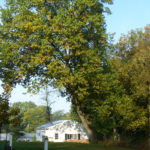
-
Acorns from the black Oak are small and bitter.
-
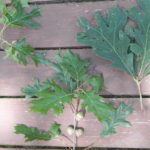
-
Oaks have different shaped leaves
-
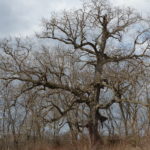
-
Century Oak Tree
-
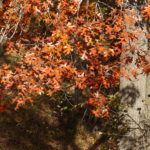
-
Oak leaves turn russet in autumn.
Acorns
Acorns are nature’s gift to many wildlife species and people. Few seeds are as abundant, large, and nutritious as acorns. Squirrels, chipmunks, muskrats, woodchucks, deer, bears, blue jays, wild turkeys, and a host of other animals gorge on them. The calorie-rich nuts help wildlife put on fat that helps them survive the coming winter.
But, there’s a problem. Oaks are erratic acorn producers. As a general rule, the white oak types only create a heavy crop every few years. Red oak type trees are more reliable but still sometimes skip a year of seed production. Sometimes few oaks in a vast area will produce acorns while an individual tree here and there will be loaded. Find a heavy acorn bearer in a scare year and you’ll have the company of many animals feeding on the nutritious nuts. Part of the reason for erratic crops stems from pollination. Oaks are wind-pollinated and a long spell of rain when they bloom in the spring can dampen pollination and eliminate a crop that autumn.
-
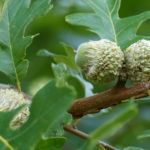
-
Acorns set up in the spring
-
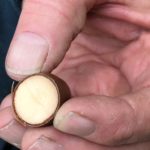
-
The white meat of an acorn.
-
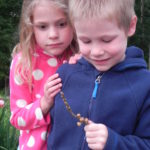
-
Two kids check out the acorns on a branch
-
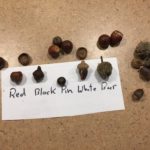
-
Iowa has many types of oaks
Acorns are a delicious human food that was relished by native people across the globe. To learn more about acorns and how to process them into food check out the Winding Pathways blog of August 2014 called Delicious Acorns.
by Winding Pathways | Jul 11, 2019 | (Sub)Urban Homesteading, Garden/Yard, Trees
Early one May afternoon we arrived home, glanced into the woods past our property, and were astonished to see an enormous red oak on the ground. The tree looked healthy, solid, and unlikely to topple, but it fell on a clear calm day. On its way down the old veteran broke two younger trees growing nearby.
A week or so later we woke to an enormous crash. It was pitch dark so we were only able to search around with a flashlight to learn that nothing had hit our house. The next morning, we discovered a giant elm prostate on the ground about 150 feet from our bedroom on a neighbor’s property. Like the oak, it fell when it was calm. Unlike the oak, the elm had been dead for years and many mushrooms were growing from its trunk.
We enjoy a huge diversity of birds and other wildlife in our yard, in part because we adjoin Faulkes Heritage Woods, a 110 wild forest protected by a conservation easement. The Woods have not been logged for over a century, so many enormous oaks, hickories, and maples live there. Many are dead or in decline, but that’s great for wildlife.
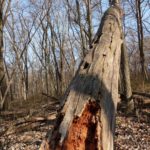
Dead trees provide food and nesting sites
Of all landscape features few are as valuable to as many wildlife species as an old dead tree. Nearly as soon as a tree dies insects, bacteria, and fungus begin the long process of recycling wood and bark back into humus. Woodpeckers drill into dead trees to extract tasty insects and carve out nesting cavities. Often their old cavities are used by chickadees, wrens, and many other cavity nesters. Dead trees are favored perching sites for raptors, perhaps because they are leafless, so the sharp-eyed birds can spot prey on the ground.
We let dead trees stand on our property, as long as they are far enough away from the house so they can’t cause damage or injure someone when they crash down.
Are Dead Trees Dangerous
We’ve been in the right place at just the right time to see big trees fall. Usually, there’s a crack or two before a giant tree crashes down with lightning speed. If someone were underneath it then it would be hard to run fast enough to escape injury.
The odds of a person being hit by a falling tree while walking along a trail are infinitesimally small. It almost never happens. Most injuries and fatalities occur when people camp, picnic, or sit under a tree. The risk comes because they are under the tree for hours while sleeping or in a position where they can’t run and escape quickly.

Look up when placing your tent near trees.
Before setting up a tent always look up and never pitch it under a weak or dead tree that could fall in the night.
How to Tell If A Tree Is Likely to Fall
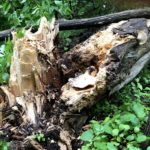
It’s a wonder this tree stood as long as it did.
Determining if a tree is likely to fall isn’t always easy. Sometimes seemingly healthy strong trees fall over, but often one gives notice that it is in decline and weakening. Here are visible signs that a tree is vulnerable to falling:
- It’s dead. No leaves. Branches occasionally dropping off. Bark sheathing off.
- It’s alive but increasingly branches are dying and are bare of leaves.
- Mushrooms are growing from the wood.
- Little piles of sawdust at the base show that insects or woodpeckers have been at work.
- It’s old. As trees age, they stiffen and eventually, their wood weakens. Young healthy smaller trees are more flexible and bend back and forth in heavy wind without damage. Wind can crack the wood of old stiff trees.
- All trees eventually fall down but some have notoriously weak wood that breaks easily. Silver maples, black locust, and Siberian Elms often shed big limbs or break during storms.
Should I Have A Tree Taken Down?
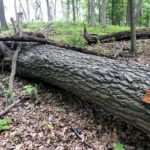
Log ready to be bucked up to firewood.
Losing a beautiful old tree is painful, but there is a time when the tree should be removed to prevent an injury, death, or damage. At Winding Pathways, we let even old weak trees stand as long as they are well away from the house or places where sit. But if the tree could fall and hit a parked car, house or barn we call a tree service and have it repurposed into firewood.
This Youtube video provides an excellent overview of live and dead trees, saving or cutting the appropriate trees. My Woodlot.
by Winding Pathways | Mar 7, 2019 | (Sub)Urban Homesteading, Garden/Yard, Trees
Catalog Dreaming
While subzero cold enveloped Winding Pathways we discovered delightful seed and nursery catalogs in our mailbox. Leafing through their photos of rosy ripe tomatoes, peaches, and sweet corn made us dream of warm days as the frigid wind whistled around the house. Catalogs also made us think of our upcoming cherry tree crop.
We love our cherry trees and are happy to have two types growing at Winding Pathways. Most are the wild native Black Cherry, a member of the Rose family and common throughout the Eastern half of the United States.
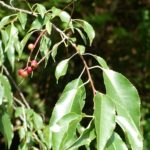
Black cherry juice was mixed with brandy or rum to make “Cherry Bounce.”
Early pioneers sometimes called this tree the Cherry Bear because bruins would walk for miles to feast on its juicy fruit. Bear cubs learned how to climb trees by following their mother up the trunk to reach ripe fruit.
Birds love wild cherries. They’ve helped spread this tree far and wide by feasting on a cherry dinner here and then flying there to poop out the seeds. In many areas, the American Black cherry is almost an invasive species, but one with many attributes.
Thomas Jefferson’s Cherry Tree Wood
People today rarely bother eating the bitter small fruits, but pioneers made Cherry Bounce by mixing the juice with brandy or rum to make a bitter, but flavorful, cordial. Most people today enjoy this tree for its beautiful cabinet wood. When newly cut it is goldish in color, often with an intricate grain pattern. The wood darkens with age. Visitors to Thomas Jefferson’s home, Monticello, Charlottesville, Virginia, often wonder why our third president loved such dark paneling. They don’t realize that when he lived there the newly installed wood glowed with cherry’s warm texture. Two centuries of aging have darkened it.
In our mail recently came the newsletter of the National Arbor Day Foundation with an amazing story about today’s popular Bing Cherry. That’s the delicious fruit often sold in grocery stores to be eaten fresh. In 1847 Henderson Lewelling, of Salem, Iowa, loaded his eight children, pregnant wife, and 700 of his prized cherry tree shoots packed in dirt-filled boxes, into wagons for the long trek to Oregon. They endured freezing temperatures, scurvy, and dysentery but made it and established the Pacific Northwest’s cherry industry.
Two Types
Today, two types of domestic cherry are readily eaten by people. They are distinct from the American Black Cherry and are native to Europe and Asia. One type is called Sweet Cherries with the Bing variety best known. They are delicious when eaten fresh. Sweet cherries thrive in California, Oregon, Washington, Idaho and Montana but don’t like the upper Midwest’s harsh winters. Ironically, Bing cherries got their start in Iowa but don’t grow well in the state today. We don’t have any at Winding Pathways.
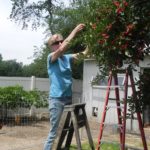
Tart cherries make great pies.
We love our sour cherries. They thrive here despite winter’s cold and summer’s inferno, yielding an abundant crop in June. Most commercial sour cherries are grown in Michigan, but they love Iowa. Our favorite variety is the Dwarf North Star. It resists bugs and diseases, and even the deer leave it alone. In some years our cherry crop is almost sweet enough to eat fresh. We love them best blended with mulberries in a pie or mixed into oatmeal. A handy cherry pitter removes some of the tedium of evicting the big seed from each fruit.
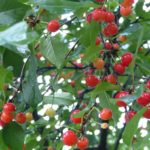
Tart cherries come ripe in June.
Planting a sour cherry in the yard yields delicious fruit for a family to enjoy. Dwarf varieties can be bought from many nurseries. They like full sun and don’t take much space. In contrast, plant an American Black Cherry and eventually, it will produce fruit savored by birds. The tree needs plenty of space. It can grow to 100 feet tall and likes full sun.
Two Great Sources to Learn About Trees

Elegant lodging awaits at the Lied Lodge.
The Arbor Day Foundation, arborday.org has a wealth of information about trees and sells dozens of species at low cost. A few years ago, we enjoyed a delightful visit to Arbor Day Farm in Nebraska City, Nebraska. We overnighted in the Lied Lodge on the property and wandered trails while enjoying tree lure. Adjacent is the home of J. Sterling Morton, Arbor Days founder.
A wonderful old book on tree natural history is a two-volume series called A NATURAL HISTORY OF TREES OF (Eastern or Western) NORTH AMERICA. If you find one at a used book store…….buy it!
ARBOR DAY
Most northern states honor Arbor Day on the Fourth Friday of April each year, but many southern states celebrate it at seasons more appropriate for planting in their climate. Arbor Day dates for all states are listed on this link.




















